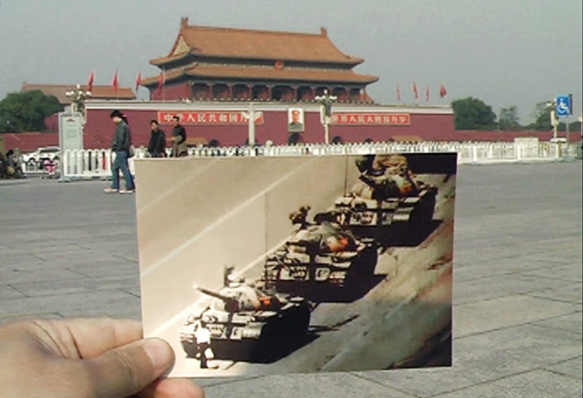Art against amnesia | Unerasable Memories – a historic look at the videobrasil collection
Unerasable Memories – a historic look at the videobrasil collection is the first major exhibition based on Associação Cultural Videobrasil’s collection, marking a watershed moment in the organization’s history. Curated by the Spanish historian Agustín Pérez Rubio, the exhibition displays geopolitical overtones in 18 pieces of work, including videos, video installations and performance recordings that reveal the social and political memories of ten countries marked by similar histories of conflict and violence. Dating from the 1980s until now, the pieces also reveal the power of the institution’s collection and its commitment to circulating art production from countries of the so-called Geopolitical South - Latin America, Africa, Middle East, Eastern Europe, South and Southeast Asia and Oceania - and seminal contemporary artists. The show is set to open on August 30 at Sesc Pompeia, in São Paulo, Brazil.
Unerasable Memories is a production of Sesc São Paulo and Associação Cultural Videobrasil – partners since 1992 in holding the Contemporary Art Festival Sesc_Videobrasil and exhibitions by prominent international artists of the likes of Olafur Eliasson, Peter Greenway, Joseph Beyus, Sophie Calle and Isaac Julien. This, however, is the first project by the two organizations to present a curated show from the Videobrasil Collection, comprising roughly 3,000 titles – including artworks, documentaries, documents, publications – amassed throughout the past 30 years.
“More than safeguarding and caring for the collection, our goal is to activate and re-contextualize the artworks from our collection,” says Solange Farkas, founder and director of Videobrasil, describing one of the main lines of work of the organization, which approaches the Collection as a permanent source of new curating and research projects. The Association is open to scheduled services to scholars and curators at its current headquarters. But soon a new center will be open to public visitation, with facilities for public visiting and consultation. Unerasable Memories is part of this endeavor, a bid to activate the collection from new perspectives. “Agustín Pérez Rubio makes connections between artwork from various periods, brings elements of the 1980s to the current context, and retrieves and updates the contents at hand. This is one of the avenues of the association’s work,” says Solange Farkas.
Artists from 10 countries revisit historical events

Liu Wei, "Unforgettable Memory", 2009, vídeo. © Acervo Videobrasil
Unerasable Memories features artwork by Akram Zaatari (Lebanon), Ayrson Heráclito and Danillo Barata (Brazil), Aurélio Michiles (Brazil), Bouchra Khalili (Morocco), Carlos Motta (Colombia), Coco Fusco (USA), Dan Halter (Zimbabwe), Enio Staub (Brazil), Jonathas de Andrade (Brazil), León Ferrari & Ricardo Pons (Argentina), Liu Wei (China), Luiz de Abreu (Brazil), Mwangi Hutter (Kenya), Rabih Mroué (Lebanon), Rosângela Rennó (Brazil), Sebastian Diaz Morales (Argentina), Vincent Carelli and Dominique Gallois (France/China), and Walid Raad (Lebanon). Their art portrays events such as colonization, the subjugation of people, slave trafficking, invasions, authoritarian political regimes, wars and racial discrimination, unveiling meanings and arousing debate about the boundaries between truth and fiction in building social memory.
“Violence, war, borders, race, sex, gender, slavery keep tormenting us. We want art to repossess this collection of experiences lived, from the beautiful to the cruelest, most inhumane, so that we may learn from them constantly,” Rubio stresses. For him, Unerasable Memories is a project against historical amnesia, a term for what happens when people forget major events, mostly negative ones, and remember the past selectively. The exhibition’s title is the same of Unforgettable Memory (photo), a piece by China’s Liu Wei, who was the start point of Agustín Pérez Rubio's research. In his video, Wei shows his fellow countrymen the famed photograph of the man who faces up to tanks at Tiananmen Square. The wary interviewees refuse to comment on the subject. Liu Wei participated in those protests, and in this piece he pays tribute to those who died, while regretting the fact that some chose to forget the facts. “A collection is all the more important and interesting as it presents us with unique experiences, lived and felt by artists who remind us of so many other possible worlds apart from the one we are in. And the Videobrasil Collection has this power,” the curator sums up.
Visitors at the exhibition, on show until November 30, may access other Videobrasil Collection pieces via the Video Library, available at computer terminals in the exhibition space. It features approximately 1300 videos, including pieces shortlisted for the Contemporary Art Festival Sesc_Videobrasil, historic videos, artist anthologies, performance recordings, and documentaries produced by the Association.
Click here to learn more about the exhibition
Service:
Unerasable Memories – a historic look at the videobrasil collection
Opening: August 30
Visitation: from August 31 to November 30
Sesc Pompeia | Rua Clélia, 93, São Paulo - SP
Tuesday to Saturday, from 10 am to 10 pm | Sunday and holidays, from 10 am to 8 pm

